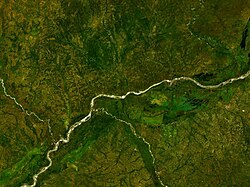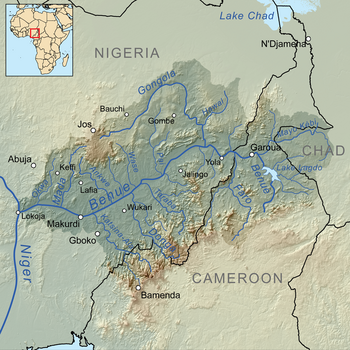Benue River
| Benue River | |
|---|---|
 | |
 | |
| Location | |
| Countries | |
| Physical characteristics | |
| Mouth | Niger River |
• location | Lokoja, Nigeria |
• coordinates | 07°45′12″N 06°45′24″E / 7.75333°N 6.75667°E |
| Length | 1,400 km (870 mi) |
| Basin size | 319,000 km2 (123,000 sq mi)[1] |
| Discharge | |
| • location | Lokoja, Nigeria (near mouth) |
| • average | 3,477 m3/s (122,800 cu ft/s)[1] |
| Basin features | |
| Tributaries | |
| • left | Mayo-Kébi, Gongola, Pai, Wase, Ankwe, Mada, Okwa |
| • right | Faro, Taraba, Donga, Katsina-Ala |
Benue River (French: la Bénoué), previously known as the Chadda River or Tchadda, is the major tributary of the Niger River.[2] The size of its catchment basin is 319,000 km2 (123,000 sq mi). Almost its entire length of approximately 1,400 kilometres (870 mi) is navigable during the summer months.[3][1] As a result, it is an important transportation route in the regions through which it flows.[4] The name Benue comes from Binuwe, meaning 'Mother of Waters’ in the Batta language.[5]


Geography
[edit]The Benue rises in the Adamawa Plateau of northern Cameroon, from where it flows west, and through the town of Garoua and Lagdo Reservoir, into Nigeria south of the Mandara mountains, and through Jimeta, Ibi and Makurdi before meeting the Niger River at Lokoja.[2]
Large tributaries are the Faro River, the Gongola River and the Mayo Kébbi, which connects it with the Logone River (part of the Lake Chad system) during floods. Other tributaries include Taraba River and River Katsina Ala.[6]
At the point of confluence, the Benue exceeds the Niger by volume. The mean discharge before 1960 was 3,477 cubic metres per second (122,800 cu ft/s)[1] for the Benue and 2,863 cubic metres per second (101,100 cu ft/s) for the Niger.[1] During the following decades, the runoff of both rivers decreased markedly due to irrigation.[citation needed]
Climate
[edit]Benue State has a tropical savanna climate. It is warm every month of the year throughout both wet and dry seasons. The annual temperature is 34°C and there is about 244 inch of rain in a year.[7] The state has an average humidity of 61%, dew point of 25 °C, an UV-index of 7 and it is mainly dry for 169 days in a year.[8]
Major floods
[edit]Nigeria’s National Emergency Management Agency (NEMA), conducted a “disaster risk management analysis” and advised Ministries, Departments, and Agencies (MDAs) to take proactive steps to mitigate the impact of climate change. The agency advised that water bodies across some states be desilted and dredged regularly to make water available for various purposes. The agency urged relevant institutions to carry out routine monitoring of dams and water bodies to ensure their operation rule curve for reservoirs is adhered to.[9]
2022 Flood
[edit]On September 23, 2022, flooding affected all riverine local government areas of Benue, according to the state Commissioner for Water Resources and Environment, Godwin Oyiwona. The flooding affected Makurdi, Agatu, Logo, Guma, Buruku, Otukpo, and Gwer-West.[10] The government worked to mitigate flooding effects and released funds for cleaning the Idye Basin.[11]
In October 2022, farmers in Adamawa State struggled to clear off remnants of crops destroyed by the flooding. The disaster disrupted many communities across Nigeria’s 36 states, with hundreds of villages and urban centers submerged in water. The disaster unsettled over 2.4 million people and over 600 fatalities were recorded. Additionally, "expansive hectares of farmlands across affected states were swept off."[3]
The worst hit were mostly residents of agrarian communities near major tributaries in seven of the 21 local government areas in the state. Within three months, 12 Local Government Areas (LGAs) were submerged, affecting 82,730 residents, 13,788 households, 51 people injured, and 27 deaths. Farmlands worth billions of naira were destroyed.[citation needed]
January 2020
[edit]President Muhammadu Buhari inaugurated a 3.35-km drainage channel project in Makurdi, Benue, to address ecological challenges in the Idye Community.[12] The project, part of the 17 ecological intervention projects, was approved by the President in the fourth quarter of 2017 and completed in 48 weeks. The project aimed to address the devastating effects of erosion and flood in the region.[13][12]
2017 Flood
[edit]News Agency of Nigeria (NAN) reported that Idye Community was among the worst-hit areas of the 2017 flood that displaced over 120,000 persons[14] in the Benue capital, Makurdi. Floods devastated more than 200 households in Makurdi.[15]
2012 Flood
[edit]The Benue River flooded in October 2012, resulting in a large increase in the population of venomous snakes in the Duguri District, Alkaleri Local Government Area, Bauchi State.[16] A July 2013 report indicated that over 200 people in the district had died of snakebite. The General Hospital in Kaltungo, Gombe State in Nigeria, is the nearest location for treatment of snakebite; "whoever is lucky to make it to Kaltungo is treated in only two days and then they return home."[17][18]
-
Benoue huts
-
Benoue view from drone
-
Crossing the Benue River from Lagdo with a Canoe
Pollution
[edit]Benue Hike Tourism and Conservation Foundation, in an attempt to keep the river protected from various forms of pollution, informed the Benue State Government about the irregularities of some companies in the state for emptying waste in the river. Waste like ethanol, that could easily cause damage to human and aquatic life, was dumped into Benue River. Subsequently, the Benue State Government took an immediate attempt in addressing the issue to prevent further damages for its citizenry.[19][20][21]
References
[edit]- ^ a b c d e "AGRICULTURAL ENGINEERING: An Introduction to Agricultural Engineering".
- ^ a b "Benue River | Nigeria, Cameroon, Chad | Britannica".
- ^ a b Babangida, Abdulkareem Mojeed, Mohammed (December 16, 2022). "SPECIAL REPORT: How poor infrastructure worsened flood disasters in states across Nigeria". Premium Times Nigeria. Retrieved July 4, 2023.
{{cite web}}: CS1 maint: multiple names: authors list (link) - ^ "Benue River". WorldAtlas. April 5, 2023. Retrieved July 3, 2023.
- ^ Njeuma, Martin Zachary (1969). THE RISE AND FALL OF FULANI RULE IN ADAMAWA 1809 - 1901 (PDF). University of London. p. 13.
- ^ "Katsina Ala River | river, western Africa | Britannica". www.britannica.com. Retrieved July 3, 2023.
- ^ "Benue weather and climate ☀️ Best time to visit 🌡️ Temperature". www.besttravelmonths.com. Retrieved September 20, 2023.
- ^ "Weather for Makurdi, Benue , Nigeria". www.timeanddate.com. Retrieved September 20, 2023.
- ^ Nseyen, Nsikak (September 19, 2022). "Flooding: NEMA issues warning to Adamawa, Taraba, Benue, others". Daily Post Nigeria. Retrieved July 4, 2023.
- ^ Simire, Michael (September 23, 2022). "Flooding hits riverine areas in Benue". EnviroNews Nigeria. Retrieved July 4, 2023.
- ^ "Flooding hits riverine areas in Benue". September 23, 2022.
- ^ a b "Buhari inaugurates 3.35km drainage in Benue". The Guardian Nigeria News - Nigeria and World News. January 3, 2020. Retrieved July 4, 2023.
- ^ "Buhari Inaugurates 3.35km Drainage In Benue". theglittersonline.com.ng. January 3, 2020.
- ^ Nigeria, News Agency of (August 28, 2022). "Floods ravage Benue villages as Governor Ortom lounges in Europe". Peoples Gazette. Retrieved July 4, 2023.
- ^ Report, Agency (September 14, 2022). "Floods destroy 200 households in Makurdi". Punch Newspapers. Retrieved July 4, 2023.
- ^ "Snakes kill over 200 people in Bauchi council, as government takes no action". www.premiumtimesng.com. Retrieved July 3, 2023.
- ^ Agbo, Catherine (July 22, 2013). "Nigeria: Snakes Kill 200 in Bauchi". allAfrica.com. Retrieved May 11, 2014.
- ^ "Bauchi residents groan over snakebites". The Guardian Nigeria News - Nigeria and World News. June 22, 2021. Retrieved July 3, 2023.
- ^ Orsar, Hembadoon (April 18, 2023). "Benue River Pollution: You Have Failed, Ortom Tells 3 Commissioners". Retrieved July 6, 2023.
- ^ Charles, John (April 17, 2023). "Ortom orders firm's probe for alleged River Benue pollution". Punch Newspapers. Retrieved July 26, 2023.
- ^ Sunday, Ochogwu (April 17, 2023). "Biotech company accused of polluting River Benue with cassava plant waste". Daily Post Nigeria. Retrieved July 26, 2023.
External links
[edit]- Chisholm, Hugh, ed. (1911). . Encyclopædia Britannica. Vol. 3 (11th ed.). Cambridge University Press. p. 754.



